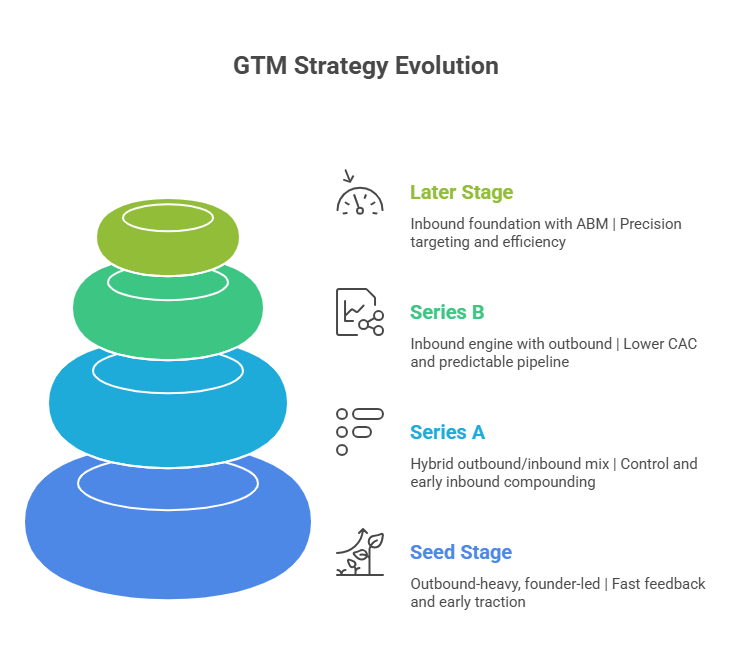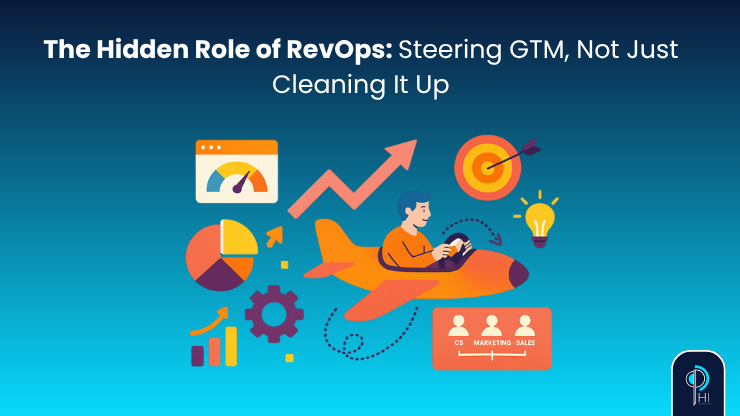When to Double Down on Outbound vs Inbound: A Stage-by-Stage GTM Roadmap
- Sani Zehra
- 4 hours ago
- 4 min read

Why This Conversation Matters
In B2B startup growth, timing your go-to-market strategy is often more decisive than the tactics themselves. What accelerates a company at Seed stage can stall by Series A.
What fuels Series A momentum can collapse at Series B. And what looks like “balance” on paper may actually be a pipeline bottleneck in practice.
Many founders underestimate how much their GTM mix should evolve as they scale. If your sales-led strategy doesn’t transition into an inbound engine at the right time, or if you lean too early on inbound when outbound is still critical, you’ll feel it in missed pipeline targets and stalled revenue growth.
The challenge is clear: When should you lean on outbound vs inbound - and how do you avoid pipeline gaps that kill momentum?
At Phi, we’ve built and executed GTM playbooks across dozens of startups in FreightTech, FinTech, and SaaS. The winners adapt their GTM motions stage by stage. The laggards hold on to the wrong motion too long - and their pipeline dries up.
Seed Stage: Outbound is Your Best Friend
At Seed, nobody knows you yet. You don’t have inbound credibility, and you can’t afford to wait six months for content or SEO to warm up.
Outbound is your fastest path to traction:
Founder-led cold outreach gets you into conversations faster than inbound can ramp. It’s often the best way to validate your ICP assumptions.
Hyper-targeted outbound teaches you more about your market than external competitor GTM audits ever could.
Every rejection = a free data point to refine your pitch. That’s a more immediate feedback loop than waiting for market sizing data to catch up.

Outbound isn’t optional at Seed. It’s your lifeline for proof points, logos, and the traction investors want to see.
Example: We helped an early-stage FinTech startup run tightly segmented outbound campaigns. Within 90 days, they landed 10 pilot customers and shortened their feedback cycle by 40%. Those outbound learnings later powered their inbound messaging.
Series A: Time for the Hybrid Hustle
By Series A, outbound-only won’t cut it. Investors expect repeatability and an early inbound engine to show signs of scaling.
Here, the model shifts into a hybrid 60/40 mix:
Outbound → Direct control of pipeline creation.
Inbound → Early signs of demand generation that compounds over time.
Think of outbound as the sprint and inbound as the marathon. You need both. For example:
Use outbound to book meetings this quarter.
Build inbound content - like GTM trigger insights or founder-led GTM playbooks - to generate traffic and leads next quarter.
The real unlock at this stage is integration. A single GTM dashboard should track both motions, ensuring outbound efforts are feeding inbound insights (and vice versa).
If your inbound engine isn’t showing signs of traction by late Series A, Series B will be a painful climb.
Example: For a Series A FreightTech company, we built a hybrid model. Outbound provided the immediate pipeline, while inbound content and SEO reduced CAC by ~30%. Together, they created predictability that unlocked their Series B.
Series B: Inbound Engine Takes the Wheel
By Series B, outbound has done its job: it got you customers, traction, and market credibility. But scaling outbound headcount is expensive and CAC bloats quickly. This is where inbound must take the wheel.
Your inbound motion should now be the engine driving growth:
Consistent organic traffic growth through SEO-led GTM channels.
A content flywheel that nurtures buyers - one of the best levers for CAC optimization.
Leads that convert at lower CAC and faster velocity than outbound prospects.

Outbound doesn’t disappear - it evolves into surgical account-based GTM plays triggered by buyer intent.
The trap here? Founders keep funding SDR headcount instead of building inbound marketing muscle.
Example: We worked with a SaaS company at Series B. Their outbound pipeline was steady but costly. By building a content-led inbound engine and layering RevOps attribution, we reduced CAC by 25–30% and shortened sales cycles by ~30%.
Later Stage: Outbound Returns, But Smarter
Once you’ve built a strong inbound foundation, outbound makes its comeback - but smarter, leaner, and more efficient.
Account-Based Marketing (ABM): Multi-channel campaigns targeted at your most strategic accounts, often supported by RevOps automation.
RevOps Alignment: Clean attribution ensures you know whether pipeline originated from inbound or outbound, a key metric in GTM maturity models.
Signal-Based Outbound: Using inbound intent signals (site visits, content downloads, event participation) as triggers for outreach. This modern approach is at the heart of cold outreach frameworks.
At this stage, inbound and outbound no longer compete. They reinforce each other. Inbound generates signals. Outbound capitalizes on them.
Investor Perspective: Growth-stage investors increasingly scrutinize whether your GTM is capital efficient. Without inbound-outbound alignment, you risk looking fragile.
The Stage-by-Stage GTM Roadmap
Stage | GTM Focus | Why It Works |
Seed | Outbound-heavy, founder-led | Fast feedback + early traction |
Series A | Hybrid (60/40 outbound/inbound) | Control + early inbound compounding |
Series B | Inbound engine + surgical outbound | Lower CAC + predictable pipeline |
Later | Inbound foundation + ABM outbound | Precision targeting + efficiency |

Founder Takeaway
Your GTM mix is never a one-time decision.
Outbound gets you off the ground.
Inbound keeps you in the air.
ABM ensures you don’t stall at scale.
The biggest GTM failures don’t come from bad products. They come from founders running the wrong motion at the wrong stage. The winners are those who pivot early, rebalance their GTM mix, and build systems for predictable, sustainable growth.
Ready to Balance Your GTM?
At Phi, we’ve seen this pattern across FreightTech, FinTech, and SaaS. From helping AtoB capture 7% U.S. market share to transforming FreightTech sales engines, we know what stage-appropriate GTM looks like.
If your pipeline feels inconsistent and you’re unsure where to double down, let’s talk. We’ll help you design a GTM roadmap that balances outbound and inbound - and scales with your stage.




Comments